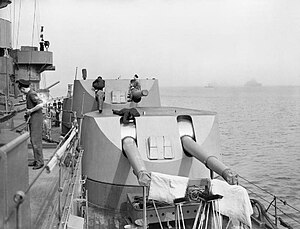
The Nelson class was a class of two battleships of the British Royal Navy, built shortly after, and under the terms of, the Washington Naval Treaty of 1922. They were the only British battleships built between the Revenge class, ordered in 1913, and the King George V class, ordered in 1936.
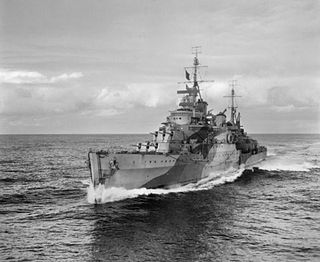
The Town class consisted of 10 light cruisers built for the Royal Navy during the 1930s. The Towns were designed within the constraints of the London Naval Treaty of 1930. The ships were built in the sub-classes, Southampton, Gloucester and Edinburgh, each sub-class adding more weaponry.

The BL 13.5 inch Mk V gun was a British heavy naval gun, introduced in 1912 as the main armament for the new super-dreadnought battleships of the Orion class. The calibre was 13.5 inches (343 mm) and the barrels were 45 calibres long i.e. 607.5 inches. The guns were greatly superior to the unrelated earlier 13.5-inch (30-calibre) Mk I to Mk IV guns used on the Admiral, Trafalgar and Royal Sovereign classes completed between 1888 and 1896.

The BL 16-inch Mark I was a British naval gun introduced in the 1920s and used on the two Nelson-class battleships. A breech-loading gun, the barrel was 45 calibres long meaning 45 times the 16-inch (406 mm) bore – 60 ft (18 m) long.
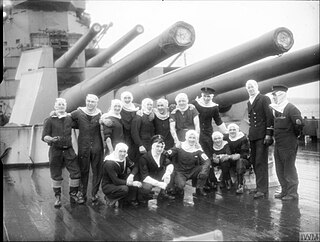
The BL 14-inch Mk VII naval gun was a breech loading (BL) gun designed for the battleships of the Royal Navy in the late 1930s. This gun armed the King George V-class battleships during the Second World War.

The QF 6-inch 40 calibre naval gun (Quick-Firing) was used by many United Kingdom-built warships around the end of the 19th century and the start of the 20th century. In British service it was known as the QF 6-inch Mk I, II, III guns. As the 15 cm/40 (6") 41st Year Type naval gun it was used for pre-dreadnought battleships, armoured cruisers and protected cruisers of the early Imperial Japanese Navy built in UK and European shipyards. It was also the heaviest gun ever carried by a pre-Cold War destroyer.

The QF 5.25-inch Mark I gun was the heaviest dual-purpose gun used by the Royal Navy during the Second World War. Although considered less than completely successful, it saw extensive service. 267 guns were built.

The BL 4-inch gun Mk VII was a British high-velocity naval gun introduced in 1908 as an anti-torpedo boat gun in large ships, and in the main armament of smaller ships. Of the 600 produced, 482 were still available in 1939 for use as coastal artillery and as a defensive weapon on Defensively Equipped Merchant Ships (DEMS) during the Second World War.

The 14-inch/45-caliber gun,, whose variations were known initially as the Mark 1, 2, 3, and 5, and, when upgraded in the 1930s, were redesignated as the Mark 8, 9, 10, and 12. They were the first 14-inch (356 mm) guns to be employed by the United States Navy. The 14-inch/45-caliber guns were installed as the primary armament aboard all of the United States Navy's New York-class, Nevada-class, and Pennsylvania-class battleships. The gun also saw service in the British Royal Navy, where it was designated BL 14-inch gun Mk II.

The BL 6-inch Mark XII naval gun was a British 45 calibre naval gun which was mounted as primary armament on light cruisers and secondary armament on dreadnought battleships commissioned in the period 1914–1926, and remained in service on many warships until the end of World War II.

The BL 9.2-inch Mark XI gun was a British 50 calibre high-velocity naval gun which was mounted as primary armament on armoured cruisers and secondary armament on pre-dreadnought battleships.

The BL 7.5-inch Mk II–Mk V guns were a variety of 50-calibre naval guns used by Britain in World War I. They all had similar performance and fired the same shells.

The BL 4-inch Mk IX naval gun was a British medium-velocity naval gun introduced in 1917 as secondary armament on the Renown-class battlecruisers and Glorious-class "large light cruisers", but which served most notably as the main armament on Flower-class corvettes throughout World War II.
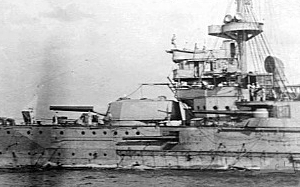
The EOC 10-inch 45 calibre gun were various similar 10-inch naval guns designed and manufactured by Elswick Ordnance Company to equip ships they built and/or armed for several countries before World War I.

The 6"/53 caliber gun formed the main battery of some United States Navy light cruisers and three US submarines built during the 1920s.

The BL 8 inch gun Mark VIII was the main battery gun used on the Royal Navy's County-class cruisers, in compliance with the Washington Naval Treaty of 1922. This treaty allowed ships of not more than 10,000 tons standard displacement and with guns no larger than 8 inches (203 mm) to be excluded from total tonnage limitations on a nation's capital ships. The 10,000 ton limit was a major factor in design decisions such as turrets and gun mountings. A similar gun formed the main battery of Spanish Canarias-class cruisers. In 1930, the Royal Navy adopted the BL 6 inch Mk XXIII naval gun as the standard cruiser main battery in preference to this 8-inch gun.
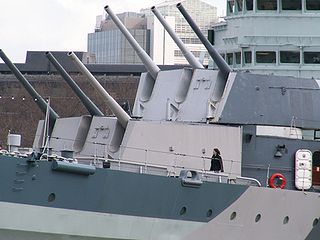
The 50-calibre BL 6-inch gun Mark XXIII was the main battery gun used on the Royal Navy and British Commonwealth's conventional (non-anti-aircraft) light cruisers built from 1930 through the Second World War, and passed into service with several other navies when ships were disposed of after the end of the War.

By taking on ships being built for foreign navies in British shipyards, a number of British-built 6-inch 50-calibre naval guns found their way into British service in World War I. Their specifications and performance differed from standard Royal Navy 6-inch guns but in British service they fired standard service 100-pound projectiles.

The 152 mm /55 Model 1934–1936 were built for the Italian Navy in the years before World War II. These guns were used on the Duca degli Abruzzi-class Light cruisers, which were the final series of the Condottieri-class cruisers as their primary armament and as secondary armament on the Littorio-class battleships.
